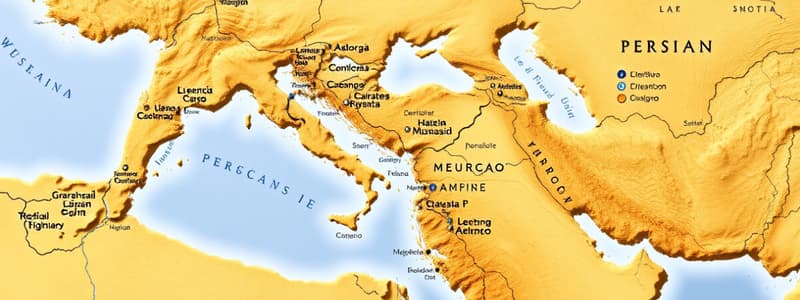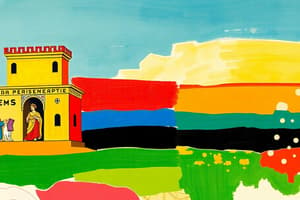Podcast
Questions and Answers
What two empires comprised the Persian Empire?
What two empires comprised the Persian Empire?
- Parthian (correct)
- Qin
- Achaemenid (correct)
- Han
Which ruler built two capitals, Susa and Persepolis, in the Achaemenid Empire?
Which ruler built two capitals, Susa and Persepolis, in the Achaemenid Empire?
Darius the Great
What was a characteristic of the Persian Empire?
What was a characteristic of the Persian Empire?
- Monotheistic religion
- Communal land ownership
- Single currency (correct)
- Ethnically diverse (correct)
The Achaemenid Empire was the smaller of the two classical Persian empires.
The Achaemenid Empire was the smaller of the two classical Persian empires.
What philosophy did Emperor Qin Shiuangdi utilize for governance?
What philosophy did Emperor Qin Shiuangdi utilize for governance?
Which dynasty established a tributary system?
Which dynasty established a tributary system?
Who was the most famous ruler of the Mauryan Empire?
Who was the most famous ruler of the Mauryan Empire?
Which empire contributed the concept of zero and chess?
Which empire contributed the concept of zero and chess?
Study Notes
Persian Empire
- Comprised two major empires: Achaemenid and Parthian.
- Utilized satraps, regional leaders, for governance and surveillance.
- Featured one of the earliest highway systems, facilitating rapid movement for armies and messengers.
- Overextension led to vulnerability against external attacks.
- Achaemenid Empire (550-331 BCE) included conquests of Lydians, Neo-Babylonians, and Egyptians.
- Darius the Great, notable Achaemenid ruler, built Susa and Persepolis as symbols of power.
- Key characteristics: advanced road network, single currency, provincial administration, patriarchal society, rigid class structure, and Zoroastrianism.
Achaemenid Empire
- The first significant Persian Empire, centered in modern-day Iran.
- Spanned from Western India to modern Turkey, nearing Greece.
Parthian Empire
- Established after Alexander the Great's death, emerging about a century later.
- Defeated remnants of Alexander's divided kingdom.
- Main rival was Rome, leading to multiple confrontations.
Qin Dynasty
- Emerged post-Warring States period (500 BCE - 200 BCE) in East Asia.
- Operated under the mandate of heaven, dictating royal authority.
- Founded by Emperor Qin Shi Huangdi, who adopted Legalism as governing philosophy.
- Established a centralized bureaucracy and dictatorship.
- Duration: 220-206 BCE; crucial for laying dynastic foundations in China.
- Innovations included the Great Wall construction, standardized measurements, and modernization of the military with iron weaponry and cavalry.
Han Dynasty
- Existed from 206 BCE to 220 CE, significantly longer than the Qin.
- Coexisted with and engaged in trade with the Roman Empire via Silk Roads.
- Capital in Chang'an (modern Xi'an); notable for building the Great Wall and extensive canal systems.
- Features: centralized governance, tributary acquisitions, military dominance using cavalry and crossbows, and advancements in postal and tax systems.
- Incorporated Confucianism into governance and effective bureaucracy.
Mauryan Empire
- Originated c. 324 - c. 184 BCE, extending from modern Pakistan to southern India.
- Ashoka, the most renowned ruler, converted to Buddhism and promoted peace and tolerance.
- Chandragupta Maurya founded the empire; significant bureaucracy enforcing a 25% agricultural tax.
- Key exports included salt, iron, and cotton cloth; utilized standardized currency for extensive trade.
- Ashoka's reign (269-232 BCE) emphasized harmony among diverse religions in India and encouraged trade connections with China.
Gupta Empire
- Existed from c. 320 CE to c. 550 CE, covering much of northern India.
- Known for cultural contributions influencing Western civilization, including the concept of zero and a numerical system identified as Arabic numerals.
- Introduced chess and made noteworthy medical advances.
Studying That Suits You
Use AI to generate personalized quizzes and flashcards to suit your learning preferences.
Description
Test your knowledge about the Classical Empires, focusing on the Persian Empire and its features. This quiz includes essential terms, definitions, and key concepts related to the governance and structure of these ancient civilizations. Perfect for AP World History students preparing for their exams.




